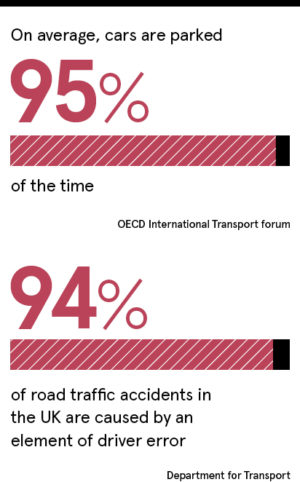Connected and autonomous vehicles (CAVs) are an opportunity to radically rethink transport within cities. However understanding where and how to deploy them requires a great deal of thought, research and nuance, as the consequences of poor implementation could have far-reaching economic, environmental and social implications.
There is currently a huge amount of global investment going into researching, building and trialling CAVs, but estimates for when they will be commonplace on UK roads vary significantly. During this time, it’s crucial that cities carefully plan where they are deployed and how they are used.
DG Cities, an urban innovation company, is playing a central role in determining this strategic deployment by understanding the impact new technologies will have on cities. Its research and innovation projects help to articulate the opportunities various technologies can bring, and ensure they are integrated and maximise value for cities, residents and businesses.
Past projects from DG Cities include the UK’s first public trials of CAVs in 2017, which led to the creation of the Smart Mobility Living Lab: London, a £20-million centre of excellence and testbed for CAVs located in London’s Royal Borough of Greenwich and the Queen Elizabeth Olympic Park.
Some of the benefits of CAVs are well understood; they include increased safety, reduced congestion and lower emissions, through electrification. Another advantage is improved accessibility, as autonomous vehicles will increase mobility for disabled, younger and older people.
“While autonomous vehicles have immense opportunity, a potential drawback is that they may exacerbate problems that cities already face,” says Trevor Dorling, managing director at DG Cities. “If cars are simply replaced with autonomous ones, this will leave many of the city’s problems unresolved. The question of interest to us is how autonomous vehicles can actually help our cities.”
DG Cities’ latest CAV research initiative, the £15-million Endeavour project, will be Europe’s largest deployment of an autonomous vehicle rideshare service. Funded by Innovate UK and industry, pilots begin in Greenwich in 2020. While a CAV rideshare has the potential to be transformational, the benefits will only be realised if they are deployed in a way that is compatible with the needs of cities.
 Through a sharing model, autonomous vehicles can make cities function more efficiently and with reduced environmental impact. Whereas the growth of cars has led to urban sprawl, an autonomous vehicle rideshare can support denser cities.
Through a sharing model, autonomous vehicles can make cities function more efficiently and with reduced environmental impact. Whereas the growth of cars has led to urban sprawl, an autonomous vehicle rideshare can support denser cities.
By operating in strategic locations, a CAV rideshare can also complement existing public transport. If placed in areas with low access to public transport, it can service communities in first and last-mile connectivity, helping them to reach transport and mobility hubs and thus supporting mixed, integrated journeys. This is demonstrated through the MERGE Greenwich project, the precursor to Endeavour, which found that up to 28 per cent of all local vehicle-based trips could be shared.
With such a service in place, and with CAVs able to move about while empty, less space would need to be devoted to cars and parking. Currently, the total parking space needed for private vehicles in Greater London is 30,350 hectares, equivalent to 22 Hyde Parks. The introduction of CAVs could free up this space for other, more productive, uses. It could also declutter the urban landscape and provide a quieter and more pleasant city experience. This model could also enable a safer environment for cyclists and pedestrians and help create more liveable cities.
“If implemented and integrated correctly, a CAV ridesharing service will have the potential to bring considerable opportunity and benefits to cities and citizens alike,” says Mr Dorling. “We want to create more liveable, pleasant and interesting cities, and we think a CAV ridesharing model is a step to achieving that.”
Connected and autonomous vehicles are just one piece of the wider smart cities jigsaw. The challenges facing cities go beyond transport, with pressures also mounting on infrastructure, services and the environment. As cities grow ever larger, these pressures will become greater and will require new, integrated solutions.
A holistic approach, cutting across multiple sectors and technologies, will be paramount to creating a city that works safely and efficiently for residents, the economy and the environment.
For more information please visit dgcities.com
